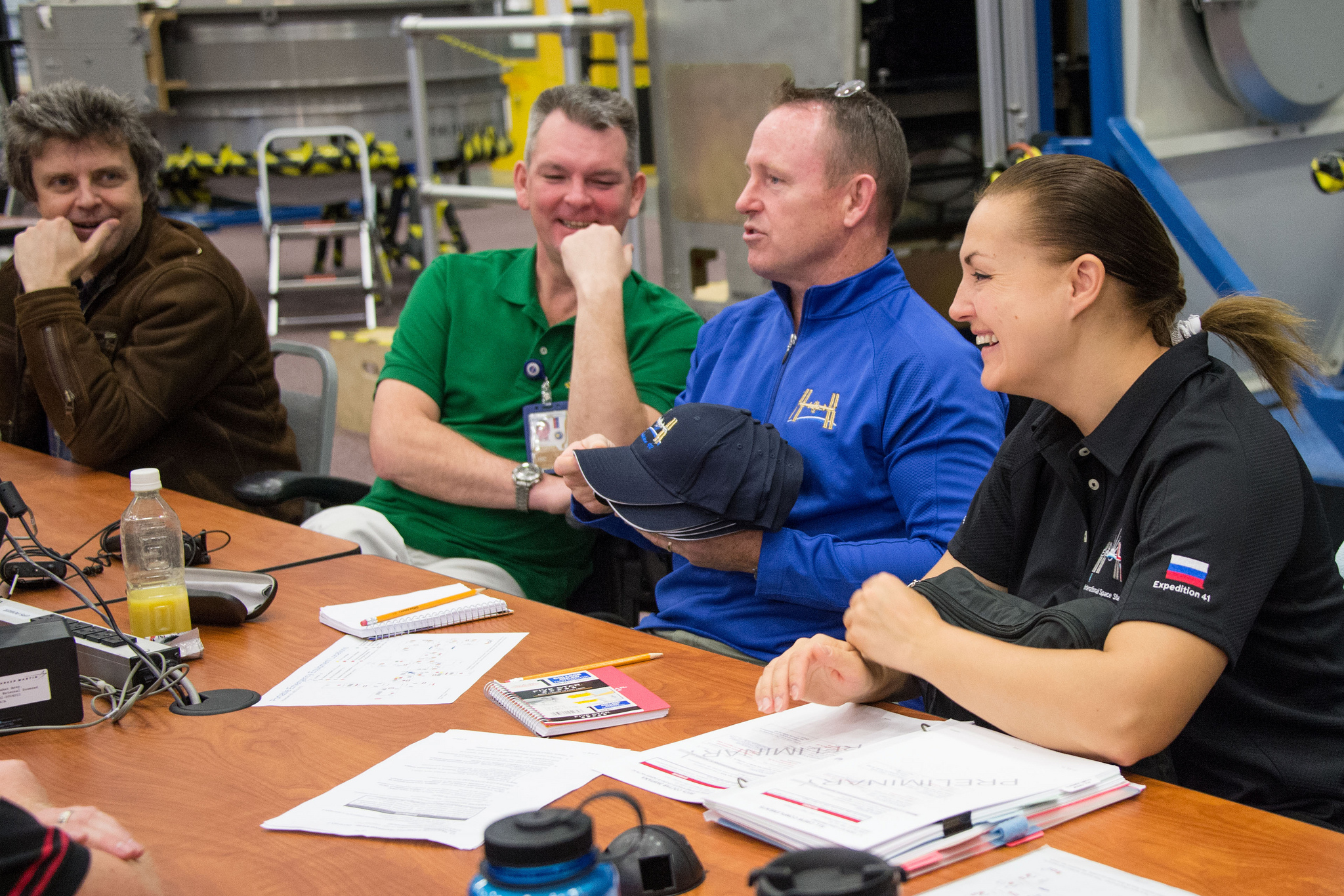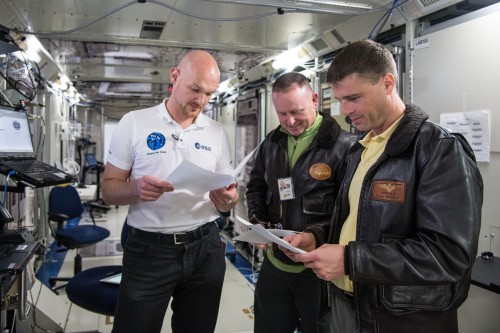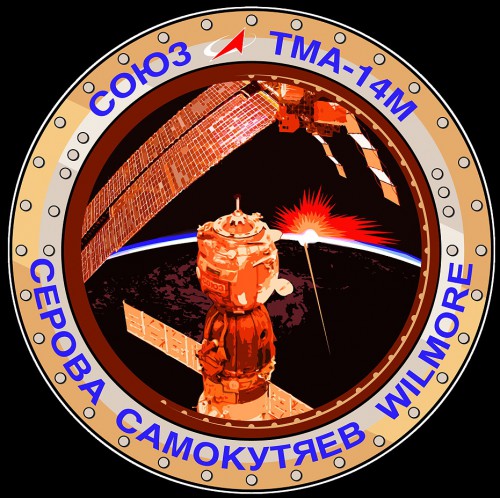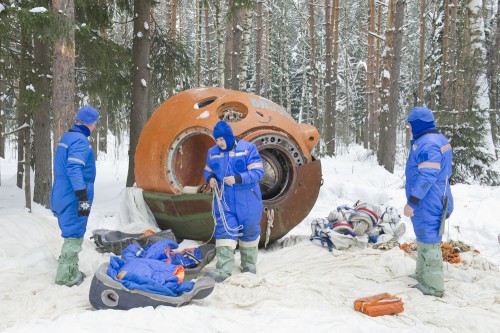
With 10 weeks to go before they head into orbit for a six-month expedition to the International Space Station (ISS), the joint U.S.-Russian crew of Soyuz TMA-14M assembled before an audience of journalists, students, and social media yesterday (Wednesday, 16 July) at NASA’s Johnson Space Center (JSC) in Houston, Texas, to discuss their upcoming mission. Russian cosmonauts Aleksandr Samokutyayev and Yelena Serova—the latter of whom will become only the fourth Russian woman in history to venture into space and the first to embark on a mission to the ISS—and U.S. astronaut Barry “Butch” Wilmore are expected to launch from the Baikonur Cosmodrome in Kazakhstan on the night of 25/26 September for a 167-day expedition that will feature several Visiting Vehicles and as many as three EVAs.
The mission is scheduled to begin with a nocturnal launch from Baikonur, after which Soyuz TMA-14M will follow the now-customary six-hour rendezvous profile to reach the ISS. This will produce a docking at the station’s space-facing (or “zenith”) Poisk module. With the exception of Soyuz TMA-12M earlier this year, all piloted missions since March 2013—five in total—have successfully executed these “fast rendezvous” regimes. Although highly complex in terms of the timing of maneuvers and orbital mechanics, the fast rendezvous is tailored in part to help reduce stress on the crew and alleviate the risk of nausea or motion sickness in the cramped Soyuz.
With Samokutyayev commanding Soyuz TMA-14M for the journey to the ISS, he will occupy the center seat aboard the spacecraft. A 44-year-old colonel in the Russian Air Force, Samokutyayev is a former squadron commander, veteran parachutist, and qualified diver and was selected as a cosmonaut in 2003. He first flew aboard Soyuz TMA-21, launching alongside Russian cosmonaut Andrei Borisenko and U.S. astronaut Ron Garan in April 2011. The trio spent 5.5 months aboard the ISS, forming the second half of Expedition 27 and the “core” of Expedition 28. During the course of the mission, Samokutyayev participated in a 6.5-hour EVA and accrued 164 days in orbit. Soyuz TMA-14M will be Samokutyayev’s second space mission.
Thirty-eight-year-old Yelena Serova will take the left-side “Flight Engineer-1” position aboard Soyuz TMA-14M. Selected as a cosmonaut candidate in 2006, she is a qualified aerospace engineer and veteran of both RSC Energia and Russian Mission Control and will be embarking on her first flight. In doing so, she will become only the fourth Russian woman—after Valentina Tereshkova in 1963, Svetlana Savitskaya in 1982, and Yelena Kondakova in 1994—to participate in a space mission, only the second to fly a long-duration expedition, and the first to fly aboard the ISS. Asked about this achievement by a member of the JSC audience, she was philosophical. Appearing non-plussed by the question, Serova replied that she does “not see my flying as such an outstanding event,” adding with a smile that it is a “regular and normal occurrence; nothing special … as far as spaceflights go!”

The final member of the Soyuz TMA-14M is 51-year-old Barry “Butch” Wilmore, who will occupy the right-hand “Flight Engineer-2” seat aboard the spacecraft. He was selected by NASA as a shuttle pilot in 2000 and a veteran of STS-129, an 11-day mission in November 2009. A captain in the U.S. Navy, Wilmore responded to one student’s question about the psychological aspects of remaining in space for six months by drawing upon his military career. He explained that he had participated in several lengthy tours at sea, in the days before email and Twitter, and that he had learned to “compartmentalize” his tasks to remain focused. However, he added that his wife had been given an iPad and that he would be having weekly videoconferences with his family from orbit.
Asked about the differences between training for a shuttle flight and an ISS expedition, Wilmore’s response was simple: the Russian language. By his own admission, he struggled with languages and knows from experience that, despite English being the “standard” aboard the station, he and his crewmates frequently use a mixture of words from each other’s native tongues (“Russlish”) to make themselves known and help each other out.
Following pressure and leak checks, the hatches between Soyuz TMA-14M and the space station will be opened and Samokutyayev, Serova, and Wilmore will board the ISS, to be greeted by the incumbent Expedition 41 crew of Russian cosmonaut Maksim Surayev, U.S. astronaut Reid Wiseman, and Germany’s Alexander Gerst. The latter were launched in late May and will remain aboard the station until November.
Aside from acclimatizing with their new environment, Samokutyayev, Serova, and Wilmore were united in their desire to head for a window almost as soon as they boarded the ISS. And one window—or, rather, windows—will top the list: the multi-windowed cupola, near the end of the Tranquility node. Reflecting on the fact that he had barely 20 minutes of “free” time on STS-129 to gaze at the beauty of the Home Planet, Wilmore said that would “look forward to sticking my nose in the cupola for at least two revolutions of the Earth.” Of course, the cupola, launched in February 2010, was not yet in place when Wilmore lasted visited the ISS, but for Samokutyayev it was and he remembers it fondly as the first place he floated to when he arrived in April 2011. Answering a question from Jim Oberg, the cosmonaut described dreaming of having a 360-degree view of Earth and compared the cupola as like a hatch in the roof of his car.

Oberg pressed him on which windows in the Russian Orbital Segment (ROS) he particularly enjoyed, and Samokutyayev replied that Window No. 9 was his personal favorite and enabled him to acquire good quality photography. This is one of 14 windows in the Zvezda service module and is set into a flared “skirt” section between the main living and working compartments. It measures 16 inches (41 cm) in diameter. Upon hearing Samokutyayev’s words, Wilmore told the audience that the crew actually designed its Soyuz TMA-14M spacecraft patch around Window No. 9. The patch shows an arriving Soyuz spacecraft, together with elements of the ISS structure—including solar arrays—brilliantly lit in the reddish-orange glow of orbital sunrise, as viewed through the large observation window. In a CollectSpace.com description of the patch, “the rising Sun announces dawn and a new expedition on the orbital research facility, expanding our knowledge and preparing for new destinations.”
When Samokutyayev, Serova, and Wilmore arrive at the station, they will do so at a particularly busy time. The fifth and final Automated Transfer Vehicle (ATV)-5, named in honor of the Belgian priest and astronomer Georges Lemaître, is scheduled for launch atop an Ariane 5 booster from the Guiana Space Centre in Kourou, French Guiana, on 25 July. Provided by the European Space Agency (ESA), this cargo craft will remain docked at the aft end of Zvezda from mid-August until late January 2015. Also attached to the ISS—assuming current planning runs to schedule—will be SpaceX’s fourth dedicated Dragon cargo mission (SpX-4), which will launch atop a Falcon 9 v1.1 rocket from Cape Canaveral Air Force Station, Fla., on 12 September, and berth at the Earth-facing (or “nadir”) port of the Harmony node about two days later. Dragon will remain berthed at the station for about a month, before being robotically detached and returned to Earth on 18 October.
In fact, almost the entirety of Samokutyayev, Serova, and Wilmore’s six-month mission will see a continuous ebb and flow of Visiting Vehicles from Russia, the United States, Europe, and Japan. Following the departure of SpX-4, Orbital Sciences Corp. plans to launch its third Cygnus cargo mission (ORB-3) on 21 October. Following its berthing at the Harmony nadir port—in a fashion not dissimilar to yesterday’s arrival of ORB-2—on the 24th, Cygnus will remain in place for about a month, prior to unberthing and a destructive re-entry on 28 November. Three days later, on 1 December, SpaceX’s fifth Dragon (SpX-5) will rocket toward the orbital outpost, berthing at the Harmony nadir on the 3rd and remaining until 8 January 2015.
Two weeks after the Dragon departs, on 25 January, ATV-5 “Georges Lemaître” will itself depart the ISS, bound for a destructive descent into the upper atmosphere. And a few days after that, on 1 February, Japan’s fifth H-II Transfer Vehicle (HTV-5), known as “Kounotori” (or “White Swan”), will launch atop a H-II booster from the Tanegashima Space Centre in southern Japan. It will berth at the Harmony nadir port about three days later, although the current volume of ISS-bound traffic also shows the launch of the sixth Dragon (SpX-6) in the same timeframe. These manifests are subject to much adjustment in the coming months. Assuming HTV-5 Kounotori launches in early February, it is expected to be unberthed and de-orbited on about 8 March, just a few days before Samokutyayev, Serova, and Wilmore board Soyuz TMA-14M for their return to Earth on 12 March.
Added to the mixture will be two Russian Progress vehicles, one to be launched in late October and another in early February, both of which will deliver food, fuel, water, and equipment to the crew.

Seven weeks into Samokutyayev, Serova, and Wilmore’s mission, the previous crew of Surayev, Wiseman, and Gerst will return to Earth aboard Soyuz TMA-13M on 10 November, completing 166 days in orbit. Surayev will hand command of the station over to Wilmore and the end of Expedition 41 will give way to the start of Expedition 42. The crew will work as a trio for two weeks, prior to the launch of Soyuz TMA-15M from Baikonur on 24 November, carrying Russian cosmonaut Anton Shkaplerov, U.S. astronaut Terry Virts, and Italy’s first female spacefarer, Sam Cristoforetti. Joining the new crew will be the first space espresso coffee machine ever to be delivered to the ISS. Following a six-hour “fast rendezvous,” the new arrivals will dock at the Earth-facing (“nadir”) Rassvet module and expand Expedition 42 to six-person strength, under Wilmore’s command.
Juxtaposed onto these arrivals and departures, the crew will participate in many scientific, biomedical, and technological investigations, as well as supporting the future development of the ISS itself. Samokutyayev and Maksim Surayev will perform an EVA from the Russian segment in October, one of whose objectives will be to install experiments to collect space dust samples for analysis of microbial development on external surfaces. In January-February 2015, Wilmore and Virts are expected to undertake a pair of spacewalks, clad in U.S. Extravehicular Mobility Units (EMUs). By this stage, the EMUs are expected to have been cleared for future EVA operations, following a lengthy investigation in the aftermath of the EVA-23 water intrusion incident in July 2013. Wilmore and Virts, who have described themselves as “the cable guys,” will be routing umbilicals and utilities in readiness for the delivery and installation of two ISS Docking Adapters (IDAs) for Commercial Crew operations in the second half of the present decade. Both IDAs are expected to be transported to the ISS by SpaceX Dragon cargo missions in the late spring and late fall of 2015.
In anticipation of the upcoming mission by Samokutyayev, Serova, and Wilmore, the Soyuz TMA-14M spacecraft arrived at the Tyuratam railhead on 26 May, for delivery to Baikonur for final pre-launch processing. Wilmore is expected to join his two Russian crewmates at the cosmonauts’ training center in Zvezdny Gorodok (“Star City”), on the forested outskirts of Moscow, in mid-August, and the trio will fly to Baikonur in Kazakhstan—along with their backups, Russian cosmonauts Gennadi Padalka and Mikhail Kornienko and U.S. astronaut Scott Kelly—in early September, approximately two weeks ahead of liftoff.
Asked what they will most look forward to on their six months in space, the sensations of weightlessness and the view of Earth seemed to predominate. Wilmore responded with just two words: “the cupola.” Samokutyayev agreed, adding that “the visual perception of Earth” and that mere cameras are no substitute for the human eye. As for Serova, the only “rookie” member of the Soyuz TMA-14M crew, she is particularly excited to experience the peculiar “free fall” of microgravity for the first time. Plus, of course, she hopes that Wilmore will allow her into the cupola, once or twice, to take a look through its 360-degree panoramic windows. “I understand it’s amazing,” she said. “Simply fantastic!”
Want to keep up-to-date with all things space? Be sure to “Like” AmericaSpace on Facebook and follow us on Twitter: @AmericaSpace



